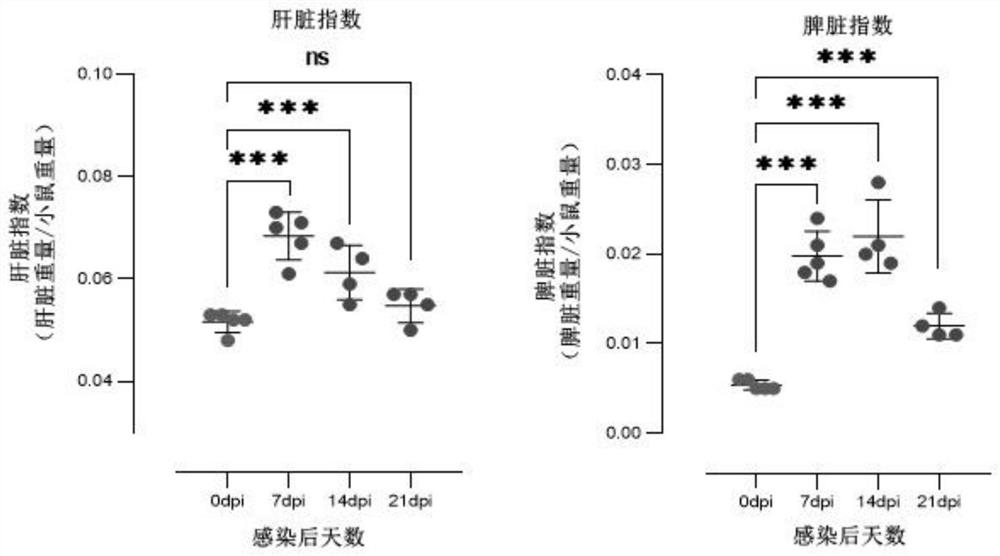Construction method of mouse talaromyces marneffei latent reactivation model
A Marneffei and construction method technology, applied in the field of bioengineering, can solve problems such as inappropriate methods for establishing latent infection models of pathogens, and no experimental mouse models for reactivating infection have been retrieved, so as to broaden research ideas and speed up experimental research. The effect of short progress and modeling cycle
- Summary
- Abstract
- Description
- Claims
- Application Information
AI Technical Summary
Problems solved by technology
Method used
Image
Examples
Embodiment 1
[0047] This example mainly introduces a method for constructing a latent reactivation model of T. marneffei in mice.
[0048] Please refer to figure 1 shown.
[0049] S1. Construction of TM-infected mice:
[0050] ① Animal feeding: After obtaining the approval of animal ethics, the mice are kept in the animal biosafety laboratory. The humidity of the animal room is constant and the temperature is 18-25 °C. During the feeding process, artificial day and night are adopted to feed the mice and sterilize them. Distilled water.
[0051] ②TM infected mice: The purified standard strain of TM 18224 was obtained from the American Type Culture Collection (ATCC). Take out the TM standard strain bacterial suspension refrigerated at 4 °C, and the concentration of the bacterial suspension can be determined by direct counting with a hemocytometer or turbidimetric method, and the concentration is 10 8 CFU / mL, mouse TM infection was achieved by tail vein injection of 0.2 mL of the suspensi...
Embodiment 2
[0063] On the basis of Embodiment 1, this embodiment further introduces the construction method of the model.
[0064] Please refer to figure 2 shown.
[0065] First, Balb / c mice were selected, and the mice were 6-8 week old female mice. Then, on day 0, the mice were acclimated to the environment, and ear tag forceps were used to make holes and mark them for subsequent experiments.
[0066] On the first day, the standard strain of TM was used to administer the mice, and the physiological indexes of the mice were regularly monitored, and the physiological indexes included: the weight of the mice, the amount of bacteria in the organs, the coefficient of the organs and the morphological identification of the TM. When the indicators indicated that the mice had been infected with TM, it indicated that the TM-infected mice were successfully constructed, and then the TM-infected mice were continuously raised.
[0067] The continuous feeding time is 7n days, and n is a natural num...
Embodiment 3
[0078] This example introduces the process of constructing TM-infected mice in step S1.
[0079] Please refer to image 3 , Figure 4 shown.
[0080] Step S1, construct TM-infected mice.
[0081] After obtaining the approval of animal ethics, the mice were raised in the animal biosafety laboratory. The humidity of the animal room was constant and the temperature was 18-25 °C. During the raising process, artificial day and night were adopted, and the mice were fed with feed and sterilized distilled water. The mice used in this experiment were Balb / c mice, and female mice were 6-8 weeks old.
[0082] On day 0, mice were acclimated and punched and marked using ear tag forceps. Then, from day 0, mice were weighed and data recorded daily for subsequent experiments.
[0083] On the first day, take out the bacterial suspension of the TM standard strain refrigerated at 4 °C, and the concentration of the bacterial suspension can be determined by direct counting with a hemocytomete...
PUM
 Login to View More
Login to View More Abstract
Description
Claims
Application Information
 Login to View More
Login to View More - Generate Ideas
- Intellectual Property
- Life Sciences
- Materials
- Tech Scout
- Unparalleled Data Quality
- Higher Quality Content
- 60% Fewer Hallucinations
Browse by: Latest US Patents, China's latest patents, Technical Efficacy Thesaurus, Application Domain, Technology Topic, Popular Technical Reports.
© 2025 PatSnap. All rights reserved.Legal|Privacy policy|Modern Slavery Act Transparency Statement|Sitemap|About US| Contact US: help@patsnap.com



